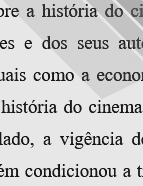

................................
The texts from this period were also part of a type of expository narrative, placing greater emphasis on critical appraisals with a strong personal bias. This period was also marked by a significant editorial surge with thematic collections from several publishers and translations of major international authors, thus allowing for the dissemination of fundamental historical and aesthetic elements. This climate of editorial euphoria reflected a general enthusiasm that stemmed, above all, from the film club movement which, in its golden age, fostered the cultural and artistic enhancement of the cinematographic phenomenon.
Precious archaeological remains may be traced back to this phase, exemplarily documenting the type of vision promoted by a group of authors on the trajectory of Portuguese cinema. Mostly supported by records of a memorialistic nature, these authors promoted a construction of the Portuguese cinematic imaginary where priority was given to the establishment of a golden age anchored on "comédia à portuguesa" [“Portuguese comedy”] and the "historical films" framed by the official vision of the regime. One of the best examples of this construction of memory is António Lopes Ribeiro, especially in the presentation and production of the television success Museu do Cinema [Cinema Museum] (1957-74), where it was possible to broadcast the great silent film classics on television.
As already mentioned, surprisingly, the first autonomous work dedicated exclusively to the history of Portuguese cinema would only emerge in the late 1970s, under Luís de Pina, and with the intriguing title of A Aventura do Cinema Português [The Adventure of Portuguese Cinema] (Editorial Vega, 1977). Prepared over the course of a decade, this "chronicle of the evolution and current status of Portuguese cinema" - as termed by the author - includes chapters dedicated to specific themes, as well as an exhaustive chronology, useful film biographies of the authors and attached bibliography. A relevant and precursory work in the historiography of Portuguese cinema, it attempted to fill "an old gap" by aiming to synthesise an "adventurous journey travelled by Portuguese cinema, the facts, the trends, the figures and the main human interpreters." (Pina, Luís de, A Aventura..., 1977, pp. 5-6).
